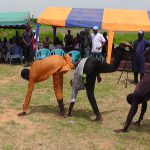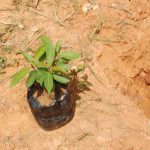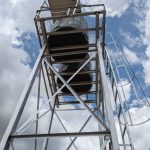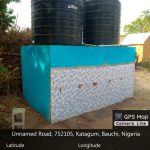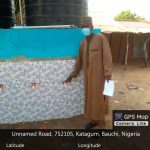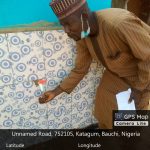THE NEWLY APPOINTED MANAGING DIRECTOR, HJRBDA, ALH. RABI’U SULEIMAN BICHI 2025
The staff of Hadejia Jama’are River Basin Development Authority, Kano welcomes the arrival of the newly appointed Management Team of HJRBDA, Kano to the Authority on the 9th April, 2025 to fulfill the promises of Mr. President’s Agenda for food security and job creation in the country.
May God give them the courage and wisdom to carryout the tasks bestowed upon them In good faith, ameen.
2024 WORLD RIVERS DAY
This is an overview of the upcoming World Rivers Day for the year 2024
2023 WORLD RIVERS DAY
BRIEFS ON ACTIVITIES AND ACHIEVEMENTS OF HADEJIA JAMA’ARE RIVER BASIN DEVELOPMENT AUTHORITY, KANO
INTRODUCTION
The Hadejia Jama’are River Basin Development Authority was created along with eleven other River Basin Development Authorities by the Federal Government of Nigeria by Decree 25 of 1976 later modified by Act No. 87 of 1979. The Authority covers an area of 45,000km2 (whole of Kano State, Jigawa State and about two-thirds of Bauchi State) with irrigation potential of about 87,000ha. and 125,000ha. in the Vallies of Hadejia and Jama’are Rivers, respectively. The Administrative Headquarters is located at Maiduguri Road, Hotoro in Tarauni Local Government Area of Kano Municipality.
FUNCTIONS
- At Inception (1976 to 1986)
- Construction and maintenance of dams and boreholes for agricultural and domestic purposes;
- Construction and rehabilitation of access roads within the projects to facilitate easy transportation of inputs and evacuation of produce within the project areas;
- Establishment of improved seeds, livestock and fish multiplication center for increase food production;
- Provision of agricultural loans and other inputs at subsidized rates;
- Facilitating efficient marketing and distribution of agricultural products;
- Mobilization and formation of farmers into self-help and co-operative groups for faster implementation of the Authority’s agricultural programmes;
- Provision of dual training and manpower development through both staff and farmers training.
- At Present (1987 to date)
- To undertake a comprehensive development of both underground and surface water resources for multipurpose use with emphasis on provision of irrigation water.
- To undertake scheme for erosion and flood control and for watershed management including afforestation and orchard development.
- To construct and maintain dams, dykes, polders, wells, boreholes, irrigation and drainage systems.
- To provide water from reservoirs and lakes for irrigation purpose to farmers as well as urban and rural water supply.
- To operate water legislation and control measures and development and update water resources master plan of the area of Authority’s development and management, and
- To undertake basis for Federal, States and Local Governments and private clients.
All the above functions are to enhance an accelerated development of irrigated agriculture to boost local production of staple food and cash crops as well as raise the standard of living of rural dwellers.
ACHIEVEMENTS
- Completed Projects
CHALLAWA GORGE DAM
The Challawa Gorge Dam is a large earthfill dam constructed on Challawa River some 90km South-west of Kano City. The dam is designed to create a multipurpose reservoir to serve the water needs of downstream areas in Kano, Jigawa, Yobe and Borno States.
Principal uses of the Project’s water include:
* To supplement water from Tiga Dam for the irrigation of about 25,000 hectares of the Hadejia Valley Project, 40,000 hectares of Kano River Project Phase II and other farms downstream of the production of rice, wheat, sugarcane, vegetables and other crops.
* Supplementing water supply to Kano metropolis and other communities
* Mandatory minimum flow releases for downstream uses in Jigawa, Yobe and Borno States,
* Flood and erosion control
* Development of fisheries and livestock, and recharge acquifers in the Basin area for successful borehole and fadama Projects.
The features of the dam are as follows:
* Length of dam – 7.804km
* Dam crest elevation – 527.45m
* Maximum height from foundation level – 42.0m
* Maximum width at base – 240.0m
* Volume of earthfill – 6.2(mcm)
* Total reservoir capacity – 930.0mcm
* Reservoir area at full capacity supply level – 100km2
* Elevation at full supply level – 523.76m
* Probable maximum flood (PFM) – 6,500m3/sec.
* Crest length of ungated spillway – 600m
* Active Storage – 904mcm
* Dead Storage – 26mcm
* Reservoir losses – 8.9mcm
* Annual yield – 470mcm
* Catchments area – 3,857km2
For the maximum utilization of this supplementary dam it is recommended that Kano River Irrigation Project, Phase II and Hadejia Valley Irrigation Project Phase II to be considered for immediate construction.
The maintenance of one-year period by the contractor expired on June 28th 1993 and the Authority is presently operating and maintaining the dam with its staff.
- Tiga Dam and Ruwan Kanya Reservoirs (Storage capacities, 1,960 million and 24 million cubic meters of water respectively).
TIGA DAM
The Tiga Dam is located on River Kano, 70km south of Kano City. It is one of the largest dams in the country and was designed and built between 1970 & 1974. This Dam is the cornerstone of water resources development in the Kano River Valley in Kano State and Hadejia River Valley in Jigawa State. The Dam sustains irrigated agriculture for thousands of hectares in Kano River Irrigation Project, Phase I and Hadejia Valley Irrigation Project, Phase I, currently being developed.
By releasing water from the dam during both rainy and dry seasons of every year, thousands of farmers along the river course, from Kano to Hadejia and beyond, grow variety of crops for both cash and food. The Dam is also another source of drinking water for Kano Metropolis, other towns and villages along the river course in Kano, Jigawa, Yobe and parts of Borno States.
Tiga Dam is part of the programme of water resources and agricultural development contemplated in the “Feasibility Study of the Chad Basin” conducted by the United States Bereau For Reclamation in the early 1960’s. The programme includes the construction of Challawa Gorge Dam on a tributary of River Kano in Kano State (completed 1992), and the Kafin Zaki Dam on River Jama’are in Bauchi State and the development of irrigation projects such as Kano River Projects I & II and the Hadejia Valley Projects I & II.
FEATURES OF THE DAM
The Tiga Dam has the following features:
Type of Dam – Zoned Earth fill
Crest Length – 6,000m
Structural Height – 48m
Hydraulic Height – 42.68m
Maximum Base Width – 274.30m
Total Storage Capacity – 1,974mil.m3
Active Storage Capacity – 1,845mil.m3
Surface Area of Reservoir – 18,900 hectares
Total Vol. Of fill Material – 9.18mil.m3
Spillway Type – Free Overflow Concr. Ogee (457m)
Emergency Spillway Width – 200m
The Dam is equipped with three outlets as follows:
- The main outlet is a 3.65mÆconduit supplying a 2.2mÆ Howell Bunger regulating valve.
- 90cmÆconduits with 60cm regulating valve.
The main Dam outlet, comprising of bulkhead gates, butterfly valve, etc, is installed in the outlet valve chamber, which is submerged 16 meters below the full supply level.
OPERATION AND MAINTENANCE OF THE DAM
In 1976, the Authority took over the responsibility of the dam i.e. operations and maintenance. With time, and due to some inadequacies in the original design and the construction of the dam, some signs of distress were observed in 1978, 1984 and 1986. These were apparent despite routine maintenance and monitoring that were being carried out regularly.
In 1986, the Authority, in conjunction with Federal Department of Water Resources, invited the Nigerian Sub-committee on Dams and experts from the United States Bureau for Reclamation to inspect the dam and advice on what should be done to save it against possible collapse. The two organizations aforementioned carried out some exercise and submitted their reports to the Authority in 1987. The reports strongly save the Dam. Some of these measures are:-
A. IMMEDIATE MEASURES
- Construction of an emergency spillway to relieve the dam embankment from excessive hydrostatic pressure
- Cleaning and clearing of the toe drains of the dam to include extending its length to cover more distance at the foot of the dam downstream.
- Cleaning, clearing and repairing the inspection chambers of the toe drain.
- Excavating the cracks observed on the dam crest, and backfilling after carrying out measurements.
- Stabilisation of the downstream slopes
- Grassing of the downstream slope and placing of rip-rap and repairs on the upstream slope
- Provision of adequate free board for the dam
- Repairing the existing hydro-mechanical equipment installed long ago
- Similar other repair works and maintenance
B. LONG TERM MEASURES
- Complete cross-sectional surveys to determine the in-situ position of the dam embankment and to establish Geodetic Triangular for the dam.
- Instrumentation of the dam
- Overhauling of the hydromechanical equipment in the outlet chamber
- Carrying out of Geotechnical investigation of the dam and its foundations
- Provision of Radio Communication and security installations
- Some additional engineering tasks such as field observation for the capacity of the additional spillway, hydrological investigation, analysis of embankment pressure distribution, slope stability analysis and development of “Dam Safety Monitoring”.
DETAILS OF PROGRESS ON REPAIRS AND MAINTENANCE
- An emergency spillway was constructed on the left hand side of the dam, 200m wide and 3.50m lower than the existing dam
- The hydromechanical equpment in the dam have been inspected and are planned to be overhauled with the gallery already cleared and cleaned, awaiting funds to repair it to its integrity level.
- The downstream slopes of the dam are protected as follows:
- Filling of deep gullies in the embankment with over 600,000meter cube of soil and about 74,000meter cube of stone aggregate
- 30,000sq.meter of grassing in the downstream face
- About 1000-meter cube of lump stones have placed in the upstream slope to protect it.
- About 2km of toe laying about 300 lengths of 225m x 10 bars x 6m uPVC-perforated pipes in graded aggregate and washed sand has rehabilitated drain.
- Provision and installation of piezometers and settlement pins have been completed.
- The dam site has now been provided with radio link (communication gadget) for effective monitoring
- Security has been installed at the entrance of the dam to ensure effective protection against trespassing and possible vandalism.
- The dam embankment has been rid of rodents and termites that might endanger its safety and integrity.
The items enumerated above needed money to execute and in early 1988 the Authority sent a memorandum to the Federal Military Government requesting funding. In March 1990 Federal Government came to the aid of this valuable investment by approving releases of funds to effect repairs on the dam and some of its appurtenances.
Presently, the repairs and rehabilitation of the dam and its appurtenances have been completed since 1992. The hydromechanical equipment over-hauling and replacement of parts and gallery have also been effected.
With the completion of the remedial works on Tiga Dam and the construction of Challawa Gorge Dam there would be enough water for envisaged projects downstream to Lake Chad. However, it has been observed that the conveyance deficiency of the river system is very low due to heavy losses which can be minimized by river training, channelization, construction head works in addition to hydro-geological investigation.
- Kano River Project, Phase I (15,000ha. of land complete with all headworks and field structures).
KANO RIVER PROJECT, PHASE I
Kano River Project, Phase I, is one of the largest and successful irrigation projects, not only in Nigeria, but also in the West African region. It is unique in its design, in that, the entire water distribution network operates on gravity. The irrigation water is conveyed from the famous Tiga Dam to the project site through an 18km long Main Canal, which splits into West and East Branch canals. These are then further broken into lateral canals, distributary canals, field channels and finally water is abstracted from the field channels to the farm for the crops to be irrigated using plastic siphon tubes.
Each of the above mentioned conveyance structures are designed to carry a designated discharge, sufficient to irrigate the area it commands. The Night Storage Reservoirs, which are constructed in different locations throughout the project area, is another unique feature of the project. These reservoirs are built to receive and store the water inflow from the branch and lateral canals during the night, which is then released to the fields the following morning. This is because the entire project has to carry out irrigation at the same time during the day and, hence large quantities of water have to be stored in different locations of the project at night when no irrigation is taking place for immediate use the following day. Also designed and built in the irrigation system is an elaborate drainage network system to drain off excess irrigation and rainwater from the project area.
LOCATION:
The Project is located in Bebeji, Tudun Wada, Bunkure, Kura and Rano Local Government Area of Kano State with Project Headquarters at Kura. It lays about 35km southwest of Kano city, on both sides of Kano – Zaria trunk road. The elevation of the project lies within 440 meters above sea level, with minimum storage level of Tiga Dam at 506.50 meters, which provides a perfect setting for gravity irrigation.
MAIN FEATURES OF THE PROJECT
Total irrigable Area – 22,000ha.
Fully developed irrigable Area – 15,000ha.
Length of Main Canal – 18km
Length of Branch Canals – 56km
Length of Secondary Canals – 320km
Length of Main Drain – 320km
Length of Collector Drains – 496km
Length of Field Canals – 1,120km
Length of Field Drains – 1,120km
Length of Service Roads – 816km
No. of Night Storage Reservoirs – 8
No. of Field Structures – 16,000Nos.
PROJECT STATUS
But for the financial constraints experienced earlier, the project would have been fully completed by 1984. Instead, 15,000ha. have been completed and put under irrigation. Work on the completion of the 7,000 hectares is expected to commence soon. The completion of these 15,000 hectares has been achieved in the following manner:
4,000ha. – by direct labour
11,000ha. – by contract
IMPACT OF THE PROJECT ON AGRICULTURAL DEVELOPMENT
With progress made over the years, the Authority has been assisting the farmers in growing dry season crops under irrigation and rainy season crops under supplementary irrigation. Despite the fact that the main function of the Authority is the development of surface and underground water resources, which is fully executed, the Authority also assists in the area of crop production, crop protection and the general crop husbandry by giving technical advice to the farmers all over the project area. In addition, the Authority has launched a programme of facilitating the participation of farmers in Irrigation Management through the formation of organized groups of water users (Water Users Associations).
The Project has over the years improved the living standards of the farming communities within and outside the project area in the following major areas:
- Provides all year round employment for over 35,000 farmers and their families
- Farmers produce over 150,000MT of food and cash crops valued at about #2.7billion annually. In the year 2001/02 farmers realized higher revenues due to the good prices offered in the market for their produce as could be seen in the table below.
- Provides over 1.5million man days of employment to farm labourers from within and outside the project area annually
- Contributes significantly toward enhancing national food security.
- Generates about 100,000MT of crop residues, which is used as fodder in the livestock sub sector.
- Provides raw materials for agro-based industries and created a good environment for the establishment of over 200 cottage (rice milling) industries in the project area.
- Provides employment to over 20,000 women in local processing and marketing of agricultural commodities.
- Provides employment to over 1,500 commodity merchants & brokers in the project area.
| CROP PRODUCTION AND FARMERS GROSS REVENUE – | |||||
| KANO RIVER IRRIGATION PROJECT I, 2020 – 2022 | |||||
| WET SEASON 2020 | |||||
| CROP | AREA | AV YEILD | PRODUCTION | PRICE/MT | VALUE |
| TYPE | CROPPED | (MT/HA) | (MT) | (=N=) | (NAIRA) |
| (Ha) | |||||
| Rice | 14,000 | 4 | 56,000 | 1,040,000.00 | 58,240,000,000.00 |
| Maize | 200 | 3 | 600 | 800,000.00 | 480,000,000.00 |
| Sorghum | 500 | 1.2 | 600 | 760,000.00 | 456,000,000.00 |
| Millet | 250 | 1 | 250 | 730,000.00 | 182,500,000.00 |
| Cowpea | 50 | 0.8 | 40 | 1,100,000.00 | 44,000,000.00 |
| Sub-total | 15,000 | 57,490 | 59,402,500,000.00 | ||
| DRY SEASON 2020/2021 | |||||
| Wheat | 4,400 | 2.4 | 10,560 | 1,200,000.00 | 12,672,000,000.00 |
| Maize | 3,450 | 2.5 | 8,625 | 800,000.00 | 6,900,000,000.00 |
| Tomato | 2,700 | 15 | 40,500 | 100,000.00 | 4,050,000,000.00 |
| Onions | 1,950 | 27 | 52,650 | 75,000.00 | 3,948,750,000.00 |
| Cowpea | 300 | 0.7 | 210 | 1,100,000.00 | 231,000,000.00 |
| Others | 200 | 10 | 2,000 | 50,000.00 | 100,000,000.00 |
| Fallow | 2,000 | 0 | 0 | 0 | 0.00 |
| Sub-total | 15,000 | 114,545 | 27,901,750,000.00 | ||
| G/Total | 0 | 172,035 | 87,304,250,000.00 | ||
| WET SEASON 2022 | |||||
| CROP | AREA | AV YEILD | PRODUCTION | PRICE/MT | VALUE |
| TYPE | CROPPED | (MT/HA) | (MT) | (=N=) | (NAIRA) |
| (Ha) | |||||
| Rice | 13,800 | 4 | 55,200 | 1,040,000.00 | 57,408,000,000.00 |
| Maize | 250 | 3 | 750 | 800,000.00 | 600,000,000.00 |
| Sorghum | 520 | 1.2 | 624 | 760,000.00 | 474,240,000.00 |
| Millet | 550 | 1 | 300 | 730,000.00 | 219,000,000.00 |
| Cowpea | 130 | 0.8 | 104 | 1,100,000.00 | 114,400,000.00 |
| Sub-total | 15,000 | 56,978 | 58,815,640,000.00 | ||
| DRY SEASON 2021/22 | |||||
| Wheat | 4,000 | 2.4 | 9,600 | 1,200,000.00 | 11,520,000,000.00 |
| Maize | 3,800 | 2.5 | 9,500 | 800,000.00 | 7,600,000,000.00 |
| Tomato | 3,100 | 15 | 46,500 | 100,000.00 | 4,650,000,000.00 |
| Onions | 2,000 | 27 | 54,000 | 75,000.00 | 4,050,000,000.00 |
| Cowpea | 320 | 0.7 | 224 | 1,100,000.00 | 246,400,000.00 |
| Others | 500 | 10 | 5,000 | 50,000.00 | 250,000,000.00 |
| Fallow | 1,280 | 0 | 0 | 0 | |
| Sub-total | 15,000 | 124,824 | 0 | 28,316,400,000.00 | |
| G/Total | 0 | 181,802 | 0 | 87,132,040,000 | |
PROSPECT
With the expected commencement of works on the completion of the remaining 7,000ha. of the project and the on-going rehabilitation works on the completed area, the benefits accruing to the farmers and the Nation are expected to increase by about 40% within the next couple of years. In addition, with recent programme of involving beneficiary farmers in the operation, maintenance and management of the irrigation system, a bright future awaits both the farmers and the Authority alike in making a sustainable use of the facilities put in place for profitable crop production.
- Jido Dam (Storage capacity 150,000 cubic meters of water), Bela-Taba Dam (Storage Capacity 2.50mcm of water) and Sawe Lake (500,000 cubic meters of water) handed over to the rural populace for operation and maintenance.
- Wudil Pilot Irrigation Scheme (260 hectares of land including pumping maintenance to various communities and Local Government.
HADEJIA VALLEY IRRIGATION PROJECT-PHASE I.
The Hadejia Valley Project, Phase I lies within Auyo, Kaugama, Miga & Kafin Hausa Local Government Areas of Jigawa State between the Hadejia River and its branch, the Kafin Hausa River. It is a multi-purpose project and involves the land, water resources and irrigation development to enhance agricultural production in the predominantly farming communities within the Project area. The project is designed in such a way that water released from the upstream Challawa and Tiga dams, into the river system could be used for irrigation. A barrage/storage pond was constructed to store the water and from there the water is diverted through water control structures into the irrigation canals of the project.
Originally, the project was contracted in 1981 for the development of the whole of Phase I which comprises about 12,500ha. of farmlands. However, the contract was suspended in 1984 due to financial constraints. At the restarting of the works in 1992, the original contract was divided into two Stages (Stage I and Stage II). The contract is for the construction of the Hadejia Valley Project, Stage I of Phase I, which involves the development of 19 sectors with a total net area of about 6,109ha. farm land.
The Hadejia Valley Irrigation Project is a gravity irrigation scheme all through the network, starting from the diversion structure to the canal system comprising the Feeder Canal, the North Main Canal, the Distributary Canals, the Field Channels and the drainage systems. The Field Channels feed the farm plots directly.
BENEFITS
Statistics has shown that objectives of the Project establishment can easily be achieved within shortest period of time on completing the project construction. There are potentials of producing large quantities of crops annually during the two seasons of the year, thereby generating employment to the people in the area. With the present 2,000ha. net area developed, the project farmers produce about 220,000MT of food and cash crops (wheat, rice, maize, tomato and other vegetables) valued at over #500Mil. annually.
GALALA DAM AND IRRIGATION PROJECT
The project is located in Warji and Ningi Local Government Area of Bauchi State within the Valley of Jama’are River. The project is for the design and construction of a homogenous earthfill dam to store water for irrigation, livestock, fisheries and water supply for surrounding villages. The dam is 440m in length, 12m high and stores 23mil.m3. The construction of the projected stated in 1981. The dam is 99% complete by both contract and direct labour. 1500ha. of land is available for irrigation development.
KATAGUM IRRIGATION PROJECT
Katagum Irrigation Project, which was identified in early 1970’s by Messrs. SCHULTZ International Consultant, was estimated at a gross 8,700 hectares (see fig. 1). Ancient to recent alluvium underlies the area. The scheme, which is presently under construction, is located near Katagum town on the Northwestern bank of the River Katagum. This river has large catchments in highlands south of Ningi town in Bauchi State. It is presently uncontrolled and its flow during the wet season spreads out over the low laying flood plains, which is 1 – 2km wide.
SELECTIONS AND SITING OF PILOT SCHEME
The site so selected as the water source and reservoir for the scheme is an old ox-bow lake, which is being fed by the River Katagum. The Lake has a storage capacity of about 1,500,000 cu.m. and this quantity is always replenished by pumping from the river channel using 2Nos. 60cmÆ hydraflo pumps through a 330m long natural channel. The lake uses 3Nos. 20cmÆ hydraflo pumps to pump and deliver a total of 1.50cubic meters per second of water to the 1st Phase of the scheme through an 850m long earth Feeder Canal. At the end of the Feeder Canal the Distributary Canal starts and runs parallel to the farm whereby a channel with turnout structure takes off to service individual block. Excess and unused water is drained off through the field drains to the Main Drain for discharge into a natural channel that leads to the Fadama Plains North-east of the scheme area.
CONSTRUCTION OF THE SCHEME
The scheme is planned to cover about 700 hectares for irrigation, complete with field structures. The first phase of this scheme is about 100 hectares and is being set up with the aim of introducing irrigation cultivation to the farmers in the area for improved agricultural production. The work on this scheme, both the design and the construction, is being carried out in-house i.e. using the Authority’s resources (personnel and machineries).
As stated earlier the objective of setting up this scheme is to introduce the people of Katagum and environs to irrigated agriculture as a precursor to the Jama’are Valley Irrigation Project coming up upon the construction of the Kafin Zaki Dam. Furthermore, on the completion of this Project, crops in the quantity of about 40,000 metric tones, valued at #98,750,000.00 would be produced annually by the people as improved income accrued to them.
The inadequate budgetary allocation and late releases of these meager allocations combined to slow down the completion of the project. Another additional militating factor working against the early completion of this project is scarcity of petroleum products in the country lingering for many years, while these are the main ingredients required to power engines for the project construction.
FLOOD AND EROSION CONTROL
In recognition of the dynamic nature of flood and soil erosion, devastating fertile agricultural lands and properties, the Authority reviewed and designed projects for reclaiming lands and properties.
HYDROMETEOROLOGICAL ACTIVITIES
Involvies collecting, collating an analysis of weather records and water flow in rivers, lakes and the likes.
REHABILITATION OF PLANTS AND MACHINERIES
Involves repairs, overhauling and maintenance of Authority’s Plants and Machinery.
REVITILISATION OF RIVER BASIN DEVELOPMENT AUTHORITIES.
This is for the reactivation of some of the Authority’s revenue generation assets, like orchard and seed multiplication farms, establishment of tissue culture soil laboratory, introduction to novel animal husbandry in irrigated agriculture and Nagari table water.
CROP PRODUCTION BY FARMERS
- Under formal irrigation
Farmers under the formal irrigation projects of the Authority are engaged in crop production both wet and dry seasons, producing about 250,000 metric tons of food and cash crops valued at about N6,000,000,000.00 annually.
- Under Informal Irrigation
The Authority releases water for use by farmers under informal irrigation schemes along the Kano-Hadejia-Yobe River beds for the production of food and cash crops all the year round. These farmers annually valued at about N3.6billion are producing an average of 300,000 metric tons of food and cash crops.
OTHER SOCIO-ECONOMIC BENEFITS
The large irrigation projects and Dams constructed by the Hadejia-Jama’are River Basin Development Authority as enumerated above have over years made significant impact on poverty alleviation and rural development in the following respect.
- The construction of dams and irrigation projects which normally last for a couple of years provide immediate employment and constant source of income to thousands of people within and outside the affected rural communities.
- The re-location and re-settlement of those villages affected by the projects provide opportunity for establishing well laid out rural settlements provided with some of the essential basic infrastructures and amenities.
- Guarantee of irrigation water supply to crops both during the dry and wet seasons encourage farmers to invest more in agriculture.
- Increase investment in agriculture leads to modernization and mechanization of the sector, which considerably and positively affect the living condition in the rural areas.
- Irrigation facilities enable farmers to crop their land two or more times in a year thereby doubling/tripling their output and their income per annum.
- Through supplementary irrigation during the rainy seasons, farmers are able to produce high yielding but high water-demanding crops such as rice and sugar cane, which fetch them higher income.
- Irrigation also provides opportunity to farmers to grow temperate crops such as wheat and vegetables, which are highly profitable.
- Irrigation projects provide all year round gainful employment and therefore steady income to the rural populace.
- Regular availability of adequate raw materials leads to the establishment of agro-allied industries such as rice mills and tomato processing plants in the rural areas with all the attendants’ socio-economic benefits.
- Irrigation projects encourage retention and attraction of productive labour force into the rural areas, thereby enhancing productivity and development in the rural areas as well as checking rural-urban migration with all its attendants’ problems.
- Supply of raw water through irrigation canals to the door steps of numerous rural communities apart from livestock and domestic consumption also leads to establishment of block laying industries for permanent and semi-permanent building in the rural areas.
- All year round controlled flow of water in our rivers through releases from dams facilities fisheries, livestock and small-scale irrigation development by thousands of rural communities living along the rivers.
- Provision of network of service roads within and around the project areas for transportation of inputs and evacuation of farm produce facilitate social interaction and economic transaction among various communities.
- Existence of large bodies of water such as dams, night storage reservoirs and main canals provide avenue for fisheries activities while availability of crop-residue all year round encourages livestock rearing and fattening in and around the project areas.
From experience of Hadejia Jama’are River Basin Development Authority particularly in Kano River Project, Phase I (KRP I) Kadawa, irrigation projects have been important instruments for rural development and poverty alleviation. The hitherto villages in the project area have now developed to semi-urban compared with other villages. In these villages, thatched structures have now given way to semi-permanent and permanent houses. Motor vehicles and motorcycles have replaced donkey and bicycles as means of transportation in the area. Numerous cottage industries particularly rice mills and crop-markets have sprung up all over the area generating other economic activities.
PROJECTS AND PROGRAMMES
Food security and job creation are among the authority’s top priorities. As a result, numerous jobs are being created among the Authority’s catchment population through the management, rehabilitation, and construction of large, medium, and small infrastructure projects such as dams, irrigation, water supply, and erosion control projects, among others.
However, in consonance with this, the Authority was able to realize these achievements through the following activities under the auspices of Hadejia Jama’are River Basin Development Authority, Kano.
Within the period, the Authority has so far executed the following projects;
- Dams and Reservoir Construction
- Gwani Small Earth Dam
- Zurkudu Small Earth Dam
- Kwaita Small Earth Dam
- Tafga Small Earth Dam
- Sundumina Small Earth Dam
- Rehabilitation of Dams
- Rehabilitation of Tiga Dam
- Rehabilitation of Galala Dam
- Rehabilitation of Challawa Gorge Dam
- Rehabilitation of Hadejia Barrage
- Rehabilitation of Sawe Lake
- Flood and Erosion Control
- Ajingi flood and Erosion Control
- Federal University Dutse Erosion Control
- Sankara Erosion Control
- Maigatari Erosion Control
- Birnin Kudu Erosion Control
- Kwandari Erosion Control
- Erosion Control works at Panda Hamdulllahi
- Erosion Control works at Kura
- Drainage and Access road at Rijiyar Zaki
- Irrigation Schemes Contraction
- Construction of Challawa Karaye Irrigation Scheme
- Construction of Galala Irrigation Scheme
- Construction of Katagum Irrigation Scheme
- Construction of Udubo Wabu Irrigation Scheme
- Construction of Tubewell based Small Irrigation Schemes (Various)
- Rehabilitation of Irrigation Infrastructures
- Rehabilitation of Kano River Irrigation Infrastructure
- Rehabilitation of Hadejia Valley Irrigation Infrastructure
WASH Projects Intervention:
| SN | LOCATION | PROJECT TYPE/DESCRIPTI
ON |
YEAR OF AWARD | STATUS | |||
| STATE | LGA | COMMUNITY | CONTRACTUAL STATUS (Completed or On-going) | Operational Status (Functional or Non-Functional) | |||
| 1 | Jigawa | Hadejia | Ganuwar Kuka | * Drilling of 1 No. Borehole * Installation of Power system * Erection of Plastic overhead tank * Construction of 6 cells VIP Latrine |
2020 | Completed | Functional |
| 2 | Kano | Bichi | Tahfizul Qur’an Bude | * Drilling of 1 No. Borehole * Installation of Power system * Erection of Plastic overhead tank * Construction of 6 cells VIP Latrine |
2021 | Completed | Functional |
| 3 | Jigawa | Birnin Kudu | Bigidan Village | * Drilling of 1 No. Borehole * Installation of Power system * Erection of Plastic overhead tank * Construction of 6 cells VIP Latrine |
2021 | Completed | Functional |
| 4 | Bauchi | Jama’are | Tomatoe Market | * Drilling of 1 No. Borehole * Installation of Power system * Erection of Plastic overhead tank * Construction of 6 cells VIP Latrine |
2021 | Completed | Functional |
| 5 | Kano, Jigawa and Bauchi State | Various | Various | Partnership For Expanded Water And Sanitation (Pewash) Construction Of 1no. Unit Of 6 Cells (3 Male & 3 Female) Pewash Vip Toilet Across Kano, Jigawa And Bauchi States |
2022 | Completed | Functional |
| 6 | Katsina | Jibiya | Farfaru, Yangayya, Yandaki, Ba’awa And Yanhoho | CONSTRUCTION OF 9nos. UNIT OF 6 CELLS (3 MALE & 3 FEMALE) PEWASH VIP TOILET ACROSS KATSINA STATE Construction Of Wash (Water, Sanitation And Hygiene Facilities) |
2022 | Completed | Functional |
| 7 | Kano, Jigawa and Bauchi State | Various | Various | Partnership For Expanded Water Sanitation And Hygience (Pewash) | 2023 | Procurement in progress | Procurement in progress |
CHALLENGES AND IMPLEMENTATION:
PROBLEMS AND CONSTRAINTS
The HJRBDA, one of the river basins overseen by the Federal Ministry of Water Resources, has encountered numerous difficulties since its establishment. These difficulties have limited the implementation of its intended programme and activities. Several issues can be identified, namely:
- Inadequate and unsustainable funding of Projects
- Late release of funds for capital and recurrent programmes
- Changes in Government policies which affect the function of this Authority.
- Siltation of the canals and reservoirs and menace of aquatic grasses in reservoirs and waterways.
- Weeds and typha grass menace
- Aged irrigation and other infrastructures in desperate need of repair and rehabilitation
- Rising water table, which affects some domestic facilities/utilities
- The land tenure system has resulted in fragmentation, reducing the average size of farm plots over time across irrigation schemes. This fragmentation poses limitations on the adoption of mechanisation and restricts farmers’ access to credit facilities.
Conclusion and Recommendations
Conclusion
Upon closer examination of the challenges associated with managing a large-scale irrigation project, it becomes evident that while it offers substantial advantages to the community, there is a pressing need to address its sustainability concerns. The primary concern revolves around the financial capacity of the implementing agency to operate and sustain irrigation projects effectively. The scheme implemented by the River Basin Development Authorities has garnered significant recognition due to its remarkable accomplishments and contributions to crop production. These achievements encompass crops such as wheat, tomato, vegetables, and maize during the appropriate seasons. Additionally, the scheme has facilitated the cultivation of rice, maize, and other cereals during the wet season while promoting the development of livestock, fishery, forestry, and other agricultural activities. Implementing dams and borehole programmes has additionally resulted in enhancements to the water supply. The functions and structure of the River Basin Development Authorities were altered due to the reorganization in 1987. The focus was subsequently redirected solely towards the development of water resources. Introducing novel functionalities in distant domains from the agricultural sub-sector initiatives has resulted in numerous challenges for farmers participating in the current programmes.
In conclusion, the substantial contributions of River Basin Development Authorities in addressing urgent water, environmental, agricultural, and food security challenges are significant. Hence, in light of the current administration’s commitment to attaining food security and self-sufficiency, exemplified by the recent declaration of a state of emergency on food by President Ahmed Bola Tinubu, there is a call for increased intervention in initiatives focused on river basins.
Recommendations
- To effectively respond to the present circumstances, it is imperative to revive and contextualize the integrated rural development approach implemented by the River Basin Development Authorities in the mid-1970s. The integrated approach prioritised food production and rural development within the river basin by focusing on developing land and water resources for agricultural purposes. The decline in food production observed after the abandonment of the integrated approach serves as evidence supporting the superiority of the Integrated Rural Development approach.
- Sufficient financial resources must be allocated and disbursed promptly to support the implementation of capital projects and recurrent expenses of the River Basin Development Authorities.
- It is imperative for the government to establish and uphold stable and consistent policies to foster sustainable agricultural development through irrigation and private sector involvement. This approach is crucial for instilling confidence and solidifying progress and beneficial outcomes.
- There is also a need to assist and support River Basin Development Authorities in exploring all avenues of revenue generation on the path to sustainability. As we try to reduce the overhead costs of operating and maintaining the irrigation infrastructure facilities provided, this invariably means that farmers and other stakeholders will have to take on more responsibilities. This approach is being tested in selected irrigation schemes as part of the FMWR’s implementation of the TRIMING Project.


